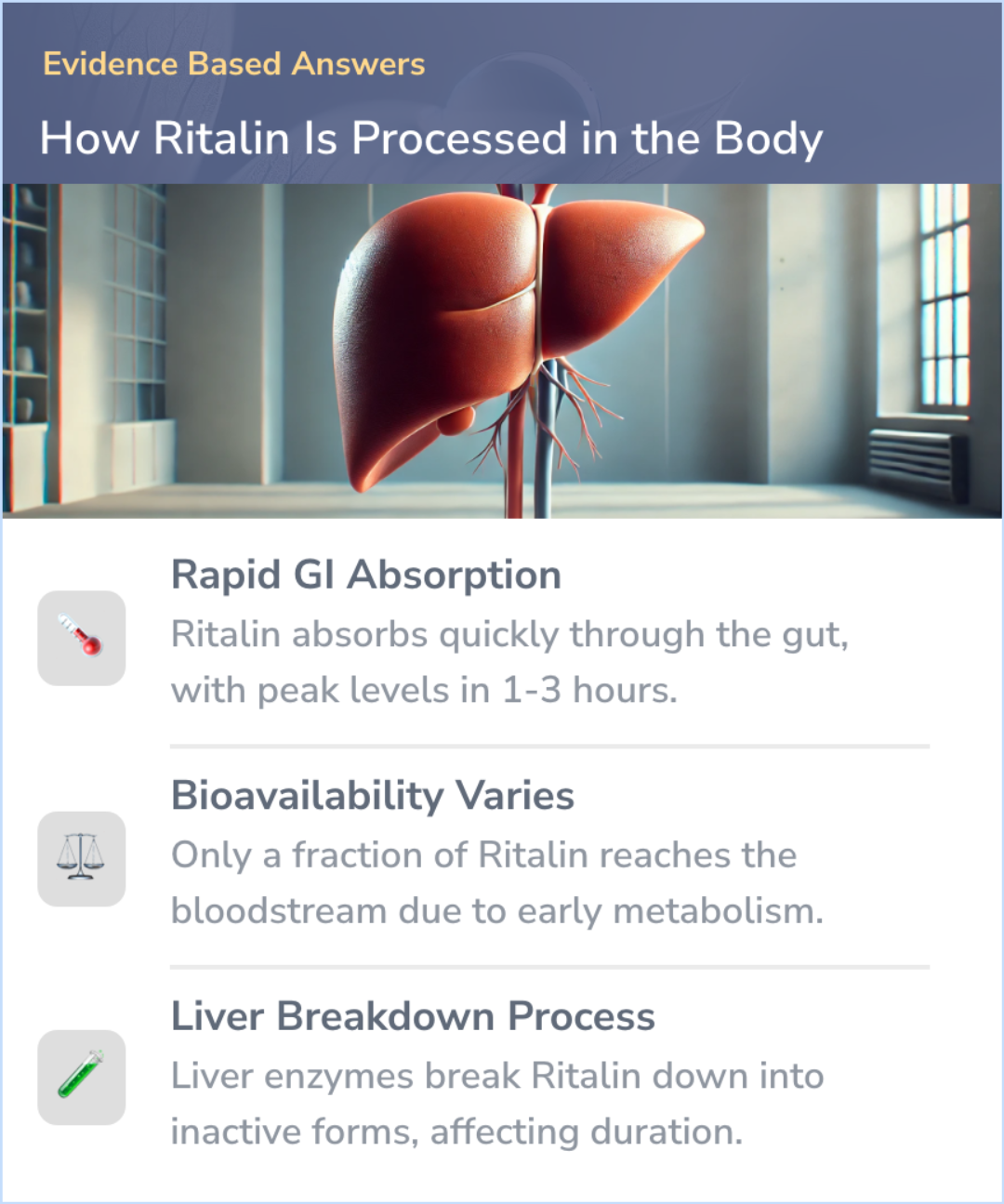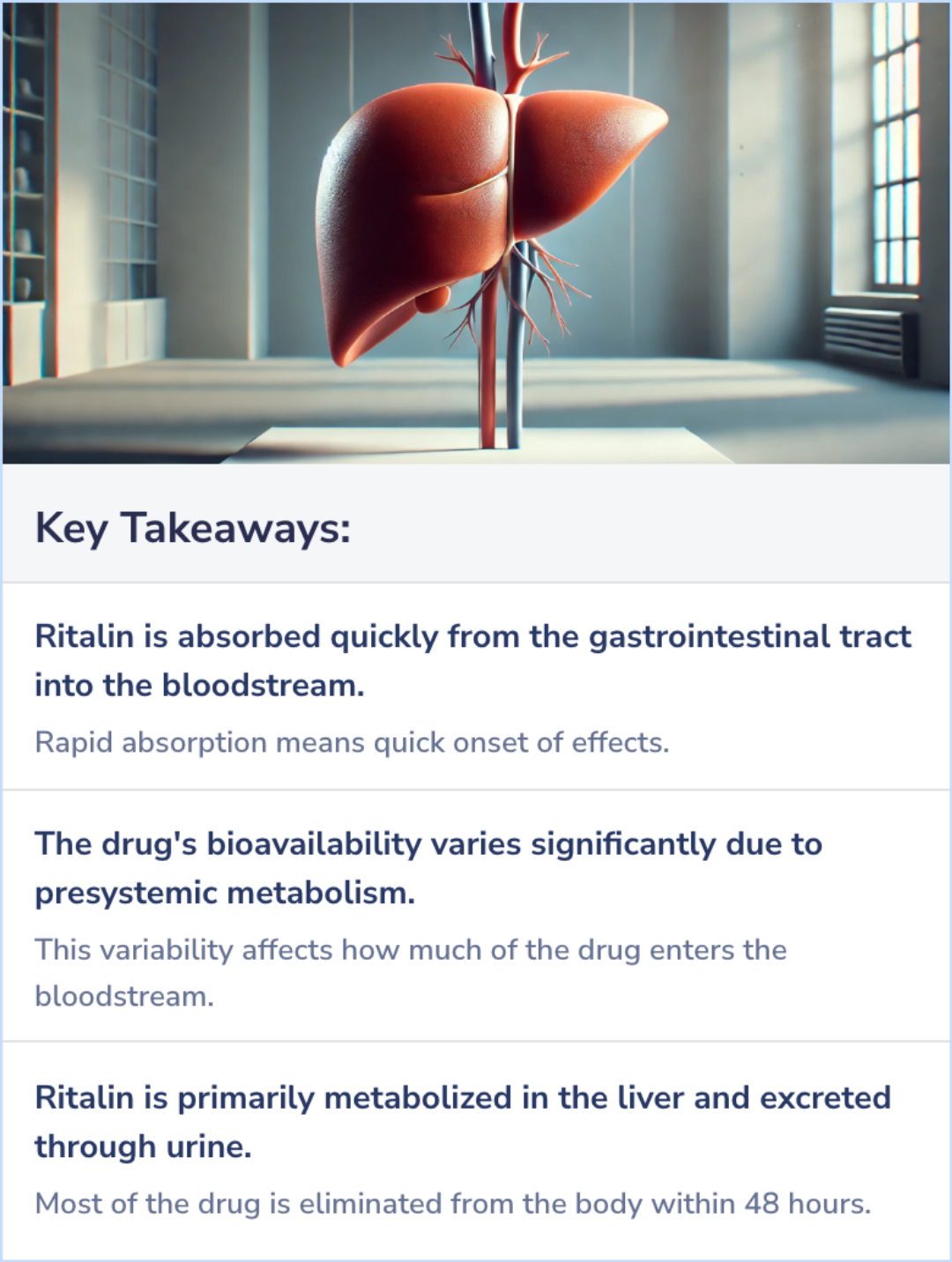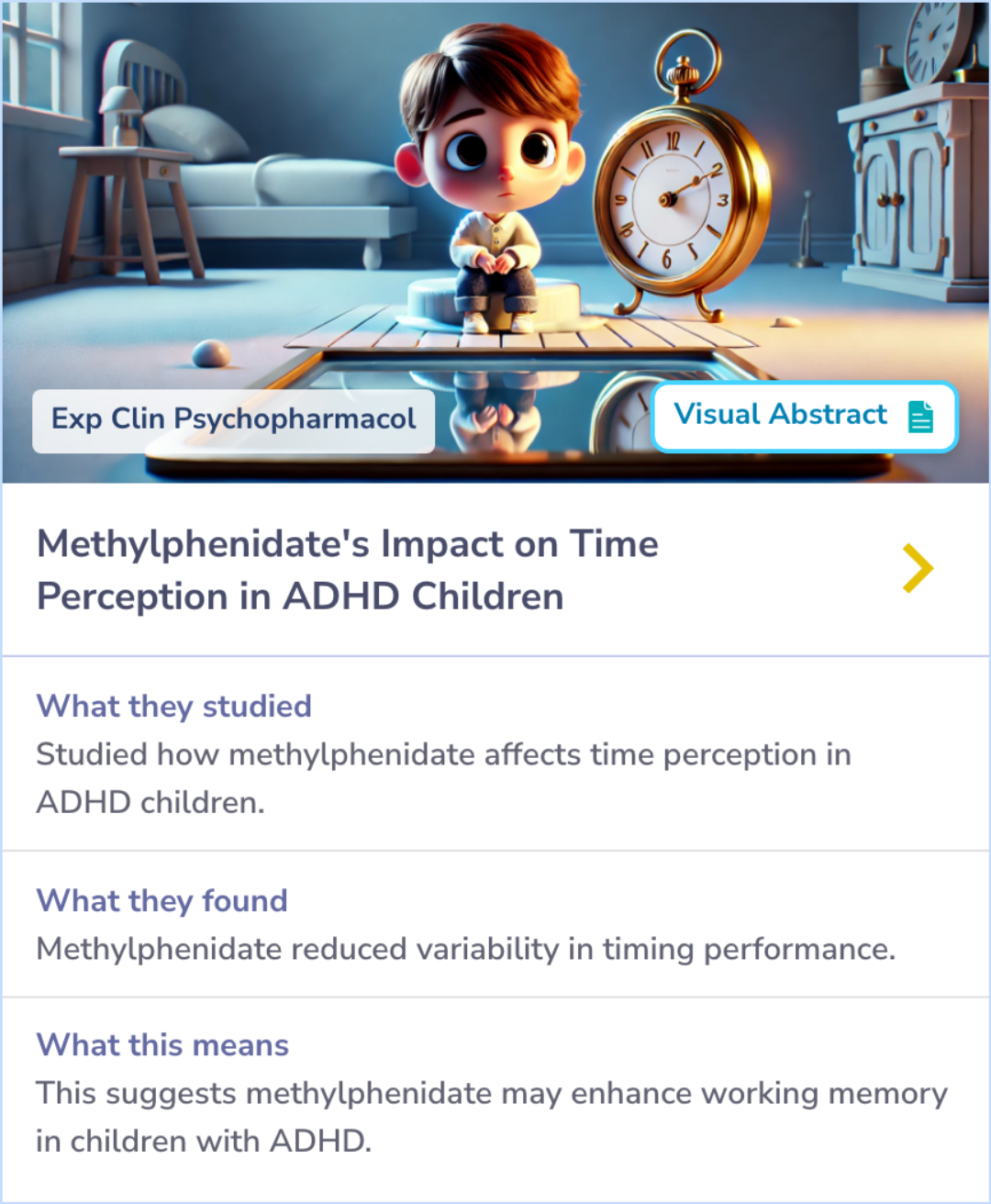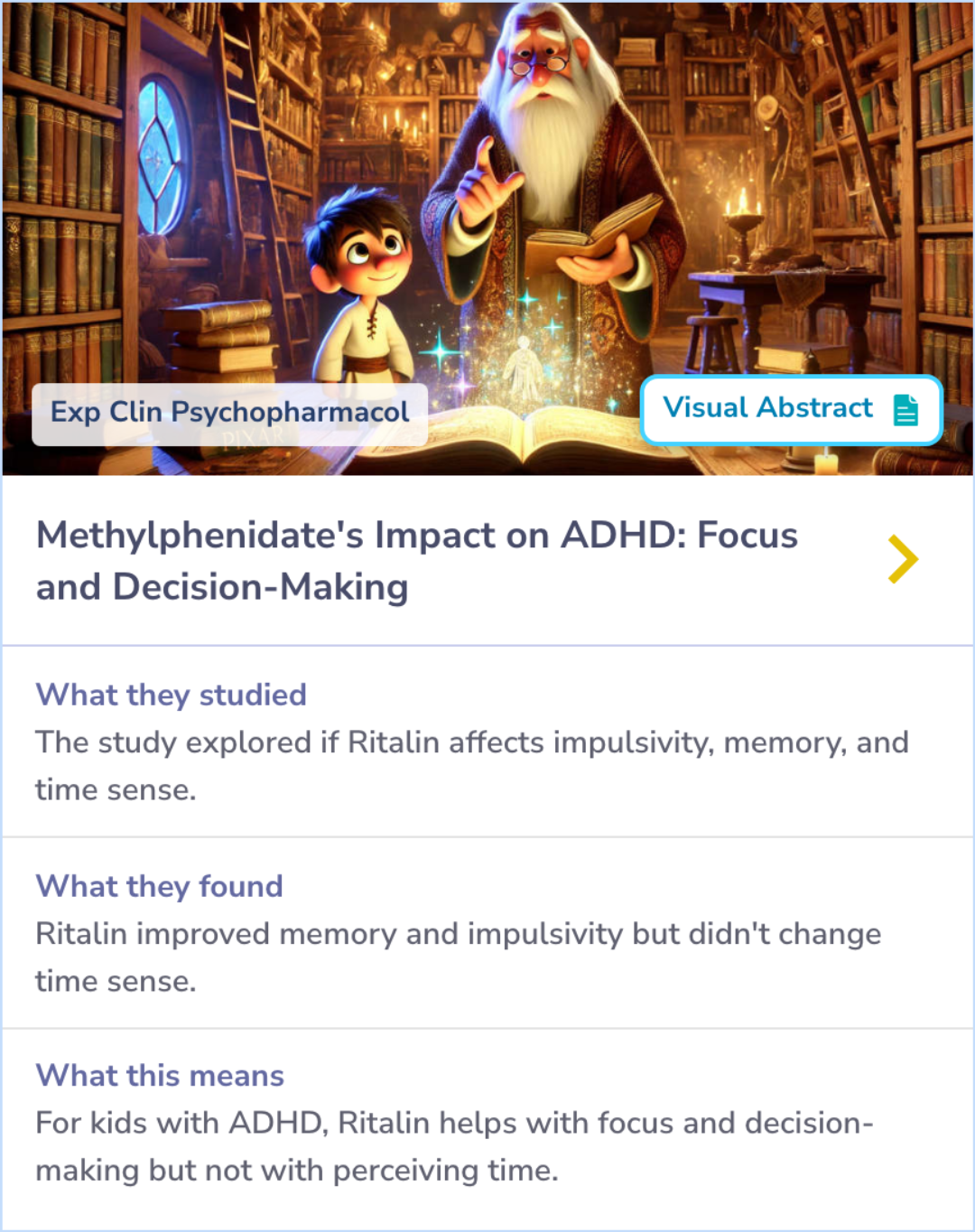Ritalin
Evidence Based Answers
How does your body digest Ritalin?
Ritalin is absorbed quickly, but only part reaches the bloodstream due to early metabolism. Liver enzymes further break it down, and the drug is mostly excreted through urine.
Published: October 25, 2024
Click to explore a section:

Ritalin absorbs fast but faces early breakdown, reducing active levels in blood.
Rapid Absorption of Ritalin
Ritalin (methylphenidate) is absorbed quickly from the gastrointestinal tract into the bloodstream. The immediate-release form reaches peak levels in 1-3 hours, while the extended-release form provides a more prolonged effect.
Food intake does not significantly change Ritalin's absorption, making its effectiveness consistent regardless of meals. However, food can slightly reduce the time it takes for extended-release forms to reach peak levels.
Food intake does not significantly change Ritalin's absorption, making its effectiveness consistent regardless of meals. However, food can slightly reduce the time it takes for extended-release forms to reach peak levels.
“
Source Quotes:
Ritalin in the SR tablets is more slowly but as extensively absorbed as in the regular tablets.
Following oral administration, MPH absorbs quickly...time to reach Cmax ranges from 1 to 3 h…
Understanding the Bioavailability of Ritalin
Ritalin (methylphenidate) is absorbed rapidly from the gastrointestinal tract, but only 11% to 53% of the dose enters the bloodstream due to presystemic metabolism. This significant range in bioavailability can lead to varying effects between individuals.
The extent of this presystemic metabolism means that a large portion of the drug is metabolized before it even enters the bloodstream, which could explain why some people experience stronger effects than others.
The extent of this presystemic metabolism means that a large portion of the drug is metabolized before it even enters the bloodstream, which could explain why some people experience stronger effects than others.
“
Source Quotes:
The bioavailability of methylphenidate varies widely, with estimates ranging from 11% to 53%, largely due to presystemic metabolism.
Ritalin Metabolism in the Liver
Ritalin is primarily broken down by liver enzymes into ritalinic acid, an inactive substance. This breakdown process, known as de-esterification, varies among individuals.
Differences in liver enzyme activity can affect how long Ritalin remains active in the body, influencing its overall effectiveness. Variability in how individuals metabolize Ritalin can lead to differences in how long the drug stays in the system and how effective it is.
Differences in liver enzyme activity can affect how long Ritalin remains active in the body, influencing its overall effectiveness. Variability in how individuals metabolize Ritalin can lead to differences in how long the drug stays in the system and how effective it is.
“
Source Quotes:
Methylphenidate is metabolized primarily to ritalinic acid by de-esterification.
It undergoes metabolism by the liver to ritalinic acid through a process called de-esterification via carboxylesterase CES1A1.
Distribution of Ritalin in the Body
After metabolism, Ritalin's active components are distributed throughout the body, including the brain, where they exert their effects. The volume of distribution for these components ranges from 1.80 to 2.65 L/kg.
Ritalin is highly soluble in lipids, allowing it to quickly spread to different tissues, including those in the brain. Its low plasma protein binding also contributes to its rapid distribution in the body.
Ritalin is highly soluble in lipids, allowing it to quickly spread to different tissues, including those in the brain. Its low plasma protein binding also contributes to its rapid distribution in the body.
“
Source Quotes:
Methylphenidate is highly soluble in lipids and shows low plasma protein binding…
Volume of distribution was 2.65 and 1.80 L/kg for d-methylphenidate and l-methylphenidate…
Excretion of Ritalin from the Body
Ritalin is primarily excreted through urine, with most of the drug eliminated within 48 hours. The main substance found in the urine is ritalinic acid, an inactive metabolite.
A significant percentage of the drug, ranging from 78% to 97%, is removed from the body through urine. Small amounts are also excreted in feces, ensuring that the drug does not linger in the body for extended periods.
A significant percentage of the drug, ranging from 78% to 97%, is removed from the body through urine. Small amounts are also excreted in feces, ensuring that the drug does not linger in the body for extended periods.
“
Source Quotes:
Methylphenidate is eliminated as ritalinic acid...predominantly with urine.
Excretion: A majority of the drug (78% to 97%) is excreted in the urine, while small amounts are excreted in feces.
Key Takeaways
Conclusions
Ritalin is rapidly absorbed into the bloodstream, and despite its quick onset, the drug's bioavailability varies widely among individuals. This variability is due to presystemic metabolism, which determines how much of the drug enters circulation.
Once absorbed, Ritalin is metabolized in the liver into an inactive form and distributed throughout the body, including the brain, where it exerts its effects. Finally, it is excreted primarily through urine, ensuring that it does not stay in the body for long periods.
Once absorbed, Ritalin is metabolized in the liver into an inactive form and distributed throughout the body, including the brain, where it exerts its effects. Finally, it is excreted primarily through urine, ensuring that it does not stay in the body for long periods.

Evidence Summary
Methylphenidate: Impact on Timing in ADHD Children
In a study, children with ADHD performed a time-production task involving holding down a lever for 10 to 14 seconds. They were tested once with methylphenidate (MPH) and once without. MPH administration reduced the variability in their timing responses, made them more likely to hold the lever for 10-11 seconds, and decreased very short lever holds. Despite these changes, MPH did not affect the number of correct responses or the average duration of lever holds, suggesting better timing control without altering overall performance.
Evidence Summary
How Ritalin Affects Impulsivity and Memory in ADHD Kids
Children with ADHD often choose immediate rewards over larger, delayed ones. This study looked at how a specific form of Ritalin, OROS-MPH, affects such impulsive decisions, as well as memory and time perception. Researchers found that the medication improved impulsivity and memory but didn't alter time perception.
Interestingly, while both impulsivity and memory improved, there was no link between these changes, suggesting different underlying mechanisms.
Interestingly, while both impulsivity and memory improved, there was no link between these changes, suggesting different underlying mechanisms.
Evidence Summary
Impact of ADHD Medications on Heart Rate and Blood Pressure
ADHD medications, both stimulants like methylphenidate and amphetamines, and nonstimulants like bupropion and desipramine, show minor increases in heart rate and blood pressure. For instance, bupropion raised systolic blood pressure by 5.9 mm Hg and heart rate by 6.9 mm Hg. These changes were statistically significant but often occurred even in those given a placebo. Both stimulants and nonstimulants led to new cases of hypertension in a small percentage of participants, highlighting the need to monitor cardiovascular health in adults treated for ADHD.


